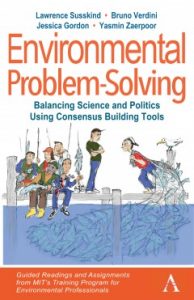Environmental Problem-Solving: Balancing Science and Politics Using Consensus Building Tools; Guided Readings and Assignments from MIT’s Training Program for Environmental Professionals
Reviewed by Lidia Cano, Massachusetts Institute of Technology
A mediation and consensus-building perspective on learning, teaching, and imbuing oneself in the world of environmental problem solving

Environmental Problem-Solving: Balancing Science and Politics Using Consensus Building Tools; Guided Readings and Assignments from MIT’s Training Program for Environmental Professionals, by Lawrence Susskind, Bruno Verdini, Jessica Gordon and Yasmin Zaerpoor, Anthem Press, 2020, 506 pp.
This book is a great tool for practitioners, teachers, students, and others looking to inform their theory of practice and gain a better understanding of environmental problem solving. It guides the reader through three initial considerations with which every environmental problem solver should be acquainted: the environmental policy-making process (and ways to influence it), the ethical dilemmas that arise when attempting to address environmental management challenges, and the diverse array of policy and project analysis tools that decision makers usually use when faced with such challenges.
The book sends a clear message: when it comes to environmental problem solving “there are no right answers.” This compendium of readings is carefully selected to help the reader reflect on key conundrums surrounding environmental problem solving from the policy-making, technical and ethical perspectives. At the end of each unit, the reader quickly realizes that the proposed study exercises are aimed at putting future problem-solvers on the spot—urging them to define their personal theory of practice.
The fact that the book’s main objective is to help learners define their own theory of practice does not mean that the authors refrain from showcasing their own. In fact, the opposite is what provides the richness of the many commentaries presented in the book. After reflecting on the work of multiple authors in the first three units, the book’s authors present a series of arguments demonstrating that environmental management decisions can never be made in an objective way. Instead, they require finding a balance between science and politics and confronting key ethical choices and non-objective judgments. This claim frames the book’s grand finale in unit four.
This unit reveals how and why consensus building is the most valuable tool for achieving the delicate balance that is needed in practice. Open public deliberation and stakeholder participation across different stages of decision-making, the authors argue, allows scientists, elected officials and stakeholders to collaborate in generating the kind of information and analyses that are needed to inform technically and politically credible decision making. And finally, consensus building can empower citizens to understand and, when necessary, challenge the assumptions on which public policy decisions are made, allowing them to contribute to the nonobjective judgments embedded in all complex environmental decisions. Such democratic engagement, despite its challenges, “can lead to ‘fairer, more stable, wiser and more efficient’ processes and outcomes,” the authors argue. Upon reading this last unit, learners can clearly see how the arguments and commentaries offered throughout the book contribute to the theory and practice of collaborative problem-solving. This is certainly what distinguishes the book from other books about environmental problem solving.
